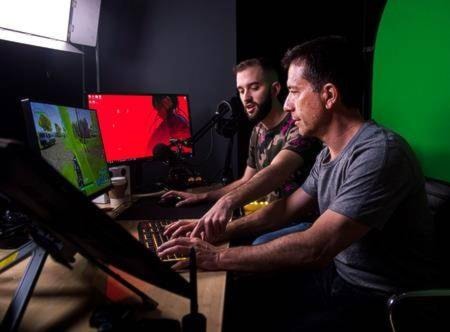TORONTO — When people ask Michael Latsky about his kids he starts by proudly sharing that his eldest son is going to be a doctor. Then, with his head hung low, he’ll mutter that his youngest, Robert, dropped out of university to pursue his dream of becoming a “YouTube personality.”
But it’s just a tongue-in-cheek act he plays for laughs. In reality, he’s proud that Robert — known online as MrWoofless for his video gaming content — discovered the “new economy” seven years ago. He no longer worries about whether he made the right choice.
“If you told me he should go back to school I wouldn’t stop laughing,” says Latsky, recalling a few milestones of success that convinced himhis 26-year-oldhad chosen the right career path.
“One of them was that he seemed to have enough money to go to my money manager, and for the money manager to be very interested in carrying his account — that was one indication. I made him go to a money manager to make sure he was under control, because a 26-year-old with whatever income he’s making may not be able to psychologically handle it.”
With the massive growth of YouTube in the last decade, including the emergence of bona fide online celebrities with tens of millions of fans, it should come as no surprise that more and more kids and teens are dreaming of a streaming career when they grow up. That’s forcing parents to grapple with the idea of their child forgoing a post-secondary education for their child’s online ambitions.
Latsky now understands the potential of the platform but wasn’t so sure seven years ago and had urged his son to reconsider dropping out of school.
“I was afraid. I was afraid if he left school and failed, where would he be?” he says.
“I sat down with him and I said, ‘That’s very nice what you’re trying to do — I don’t quite understand it — but I’m not paying for a cent towards anything you need starting from now unless you go back to school.’ My position was, if he’s not going to get a traditional education, I’m not interested in (financially) supporting him.
“It wasn’t as if I blackballed him and said, ‘Never talk to me again, I hate what you’re doing and you’re an idiot,’ it was just that I was more comfortable with him being in school while he was doing it.”
It was a little easier for Marsha Hughes to understand when her son Mitchell officially chose not to go to university.
She recalls he was about 17 when the ad revenue he was generating for his Bajan Canadian online persona took off.
“He actually started to make money in 2010, when he got a cheque from YouTube for maybe a couple hundred dollars. And then the next month it was a couple thousand dollars — and then it went crazy. And that was just the beginning,” she recalls.
“We always just assumed that he’d go to college but when he was 18, in a couple months he actually made six-figures…. We realized that even if he did this for just a couple of years and invested the money wisely this was an opportunity that was once in a lifetime. He could go to college later.”
YouTube also became a family business with the launch of the management firm Blackshore about three years ago. Hughes, the company’s vice-president of talent, advises parents to try to convince their kids to stay in school unless they’re already making a large income.
It’s getting increasingly difficult to stand out in the crowded YouTube universe, she adds, while the platform has also raised its standards for monetizing videos.
“There’s no guarantees and YouTube’s a funny world, there’s a lot of great content creators right now who aren’t doing that well and then you look at the ones who are doing well and it just doesn’t seem to make any sense,” she says.
“It’s not going to happen overnight. Even for someone like Mitchell who seemed like an overnight success, he was not. It really did take time.”
And nothing is forever on YouTube, even for its stars.
The Bajan Canadian channel has amassed more than six million subscribers and has 1.8 billion views in a little over eight years.
But the focus of the channel, the video game “Minecraft,” has gradually fallen out of fashion. Mitchell Hughes, 24, recently announced to his fans that he was rebooting his brand to focus on new topics, including the current hot game “Fortnite.”
“Let’s face it, if we look at the channel, six million subscribers and 15,000 to 20,000 views a video — this is about as close to rock bottom as I’m going to get,” he said in a self-deprecating video titled “I’m Quitting.”
“It’s not working, I’m moving on and I’m OK with that. And now it’s a great opportunity to be myself and do my thing.”
Robert Latsky, a.k.a. MrWoofless, has seen his own success ebb and flow and has friends who were forced to quit making YouTube videos professionally and reluctantly returned to conventional jobs.
“The game I started on I don’t play anymore, the second game I played I don’t play anymore, the biggest game I ever played I don’t really play anymore,” he says.
“The main ways I made money I don’t really make anymore, I make it other ways. I’ve gone through countless successes and failures within my seven years.
“A huge part of the thought process is ‘what’s next’ and how do we get on top of it.”
It’s that resilience in an ever-evolving industry that lets Michael Latsky sleep at night.
“There could be guys out there who may not be as lucky in the future but he has his head screwed on, otherwise I would’ve panicked a long time ago and I would’ve tried to do something about it,” he says.
